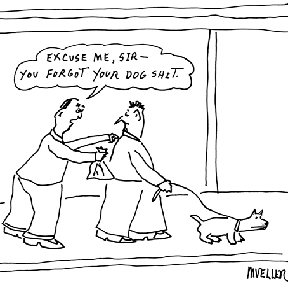The most important thing to keep in mind is that dogs are profoundly sensitive creatures that pick up on the slightest gestures, cues, vibrations. Being alert and sensitive to their cues in turn is vital to becoming leaders they respect and adore and want to follow.
First and foremost, being sensitive means paying attention to subtle body language. Theirs, ours, and that of the person passing by on the street. When we want to train a dog to follow specific commands, we tend to use sounds such as words and clicks. But when we want to communicate our general relationship to our dog, we use physical communication.
Here are some maneuvers that have been discredited with good reason, and which none of RebeccaWalks walkers would ever do (it goes without saying):
- hitting or kicking a dog for undesirable behavior
- growling at a dog
- grabbing a dog by his jowls and shaking
- alpha roll - flipping a dog onto its back and holding it down by force, sometimes followed by a nip to the neck
We own our position physically, not verbally. Dogs don't communicate by talking, remember? When we "bark" orders at them with exasperation, from a position of weakness, they understand nothing other than that we are excited, scared, or looking to fight. The below physical maneuvers can be extremely helpful (some of them as a daily practice, and others, applied on an occasional basis):
Daily: Training them to function in human society, and maintaining your position as the leader
- walk through doors first
- eat before your dog; let them smell that you are eating, but do not share (do not tease either of course)
- nuzzle your dog's nose, head, neck, body, in almost grooming motions, much like a parent dog would do to their puppy to clean them
- kiss your dog all over
- pet your dog on the top of their head (letting you do this is a sign of submission)
- play with and gently pull your dogs ears
- play with their feet
- gently bite your dog's neck, arms, and legs
- nibble on your dogs fur as if a parent dog picking out bugs or ticks; watch your dog nibble on their own fur to observe the motion
- open your mouth wide and put it over the top of your dog's nose, lengthwise (not front on. Again, just like another dog would, in play); or, put your hand(s) over the top of your dog's mouth like a muzzle (gently! it will hurt them if you are too rough.)
- put your dog belly up and gently straddle them so that their legs are behind you, not kicking at you. The difference between this and the alpha roll is very simply - the application of force (or lack thereof). In my view, if the dog is going to start kicking you, then that is not a dog you should apply the alpha roll on. This is the maneuver I go to only when a dog is absolutely ignoring my commands in a serious situation. Furthermore, I only do this with a dog I know is comfortably submissive to me. This is a reminder of who's boss, like I said, in a serious situation, not a way to train a dog to become submissive. There will be some resistance from your dog, but it should not be a true struggle - otherwise the dog will interpret your effort to dominate them in this way as a shift towards fighting mode - and owners and their dogs should never cross that line - it sets a bad precedent in the relationship and with some dogs can be dangerous.
- use a halti nose harness, which simulates another dog putting their mouth over your dog's mouth. I use a halti consistently for a few months when establishing dominance, and then only use one again when the dog has been a bit squirrely and needs to be reminded for an afternoon that, yup, I'm boss.
- when your dog is standing or sitting, put your hand over your dog's paw so you are standing on it (but not putting pressure on it of course, just engaged in the act of covering it)
- straddle your dog while standing, with your knees on the side of their back haunches, and walk forward with them playfully




No comments:
Post a Comment